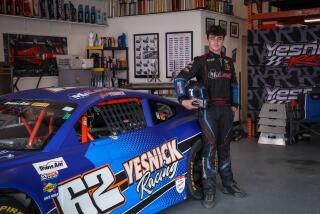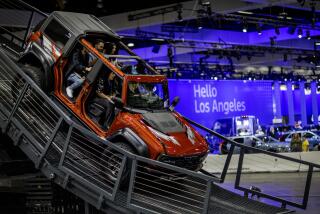Saturday Drive: 1950 Aston Martin DB2 Coupe
The car: 1950 Aston Martin DB2 Coupe
The power: 200 horsepower and an estimated 150-180 pound-feet of torque coming from a 2.9-liter, inline six-cylinder motor routing power to the rear wheels through a four-speed manual transmission.
The photos: 1950 Aston Martin DB2 Coupe
The speed: A stock DB2 clocked a 0-60 time of around 11.2 seconds and a top speed of 116 miles per hour in 1950. But these figures are for cars with the 2.6-liter inline six-cylinder rather than the larger engine in this particular DB2, so consider those numbers conservative.
The price: Estimated at $375,000-$475,000. This car will be up for auction (without reserve) by RM Auctions in Monterey on August 17th & 18th.
The details: The two-seat DB2 was the first hardtop car Aston Martin made after Sir David Brown bought and consolidated several companies under the Aston Martin name in the years after World War II. About 500 DB2’s were made from 1950-1953 and the cars were notable for its dual overhead cam, 2.6-liter inline six-cylinder engine and its four-wheel, coil-spring suspension. The suspension is independent in the front and features a live rear-axle. This model also has hydraulic drum brakes with competition aluminum drums.
This particular DB2 was originally black and featured a right-hand drive setup. It is only the 13th DB2 ever made. This is evident in the three-piece grille at the front of the car, the large vents in the quarter panel behind the front wheels and dual fuel fillers. Only the first 50 DB2’s made share these features
This car was first delivered to Canada, and it was raced in several endurance events during the 1950’s. During this time, the engine was upgraded to Aston Martin’s ‘Vantage’ specs, a change that most notably included fitting the engine with triple Weber carburetors. By 1960, the car had been retired and was discovered in a barn in many years later. A thorough restoration to the original chassis and body took place, during which the car was converted to a left-hand drive.
The DB2 was also painted the blue you see here, and fitted with a period-correct David Brown four-speed manual transmission and a larger 2.9-liter engine similar to that in the race-oriented Aston Martin DB3S. Other additions include new drum brakes; a limited-slip differential; a rollcage; racing seatbelts; and a louder, stainless steel exhaust. After the restoration, the car was dyno-tested to reveal a power output of 200 horsepower.
The drive: Sliding into the bucket seats is an easy affair with this DB2 and once you’re ensconced, you’re treated to a comfortable seating position with plenty of room throughout (especially headroom, an appreciated feature for helmet space if one plans on continuing this car’s racing tradition). A variety of chrome-rimmed gauges and switches are set within a leather-trimmed dashboard to the driver’s right, the largest of which are the speedometer and tach. A large, wood-rimmed steering wheel beckons.
The DB2 fires up with the loud tenacity for which straight-six engines from this era are beloved, before its settles into a patient idle that has a bit of an edge to it. The four-speed manual transmission has a non-synchro first gear, but it engages with a confident jab of the gearshift lever and the clutch pedal has an excellent, responsive feel. The only difficulty comes from the narrow placement of the three pedals.
The thin-rimmed steering wheel has an aged elegance to it, but from your first turn of the wheel you’re reminded that this car predates power steering and you’re going to have to work for your direction changes. Same for the drum brakes, which require more forethought when approaching a turn or stop than is necessary in today’s vehicles. But both systems work great for what they are and the tradeoff is a cerebral driving experience that modern cars have largely erased.
Through turns, as you work the steering wheel in the proper direction, the suspension keeps the car poised and in control. The ride is always comfortable and the car feels wonderfully balanced, especially considering it was engineered more than sixty years ago.
One’s heightened awareness of the act of driving in this car is aided by the engine’s eager pull, constant power and sharp note (the louder rally exhaust helps too). The experience is a visceral one and though the engine never overwhelms you with excessive noise, it remains an assertive presence during your drive. And oh does the engine love being pushed. Shifting into a higher gear is almost a letdown, as the lower RPM’s mean the engine can’t sing with the notorious voice of a straight-six. No worries; a steady push on the throttle brings you back to peak note as the scenery rushes by with increasing alacrity.
At slower speeds, prepare to become the center of attention. A random passerby waved enthusiastically from the sidewalk as we cruised by and a stoplight rendezvous with a pair of women in Century City gave them time to inquire about the car. In a city with an exceedingly high tolerance for automotive extremes, this earnest enthusiasm was refreshing.
Unfortunately, time with this DB2 Coupe was limited, so we made our way back to RM Auctions’ Century City office. Inside sit almost a dozen additional cars the company is bringing to the Monterey auction during the Pebble Beach Concours d’Elegance in August (here’s a full list) Stay tuned for more coverage leading up to the world’s most prestigious car show, including how this little gem of an Aston Martin fares at the auction.







